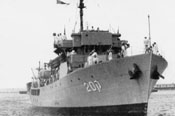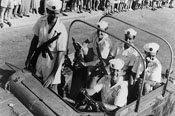Aliyah Bet & Machal Virtual Museum
North American Volunteers In Israel's War of Independence
History of the Navy
A Tiny, but Hard-Hitting Battle Force
by David Hanovice
At the onset of the War of Independence, the Israeli Navy consisted of five large ships that could be considered in the category of “warships.” An American Annapolis graduate, Paul Shulman, was commander of the navy. Among the 65 to 95 crew members of each of the warships, about three dozen were Machalniks, most from the U.S. and Canada.
Three of the five warships had been built in the US and Canada for service in World War II, than retired at the end of the war. Those three and one other were purchased for use as Aliyah Bet ships. While bringing surviving holocaust Jewish refugees from Europe to Palestine, they were intercepted by the British and impounded.
At the beginning of the War of Independence, those four ships were at anchor, rusting away along the water breaker inside the harbor area of the port of Haifa – and were known as part of the “Shadow Fleet.”
In addition to the warships, there were about two dozen small harbor craft known as the Small Fleet Crafts and a seagoing tugboat.
The four original Israeli Navy warships were:

Eilat/A-16, former Aliyah Bet Medinat-HaYehudim (The Jewish State), originally US Navy Icebreaker Northland.

Haganah/ K-20, former Aliyah Bet Hagana, originally Royal Canadian Navy Corvette Norsyd.

Wedgwood/ K-18, former Aliyah Bet Wedgwood, originally Royal Canadian Navy Corvette Beauharnois.

Maoz/ K-24, former Aliyah Bet Ben Hecht (Abril had been built in Hamburg Germany at the Krupp shipyard facilities as a passenger cruise ship named Citra and later on was sold to an American owner who operated her till the outbreak of WW II; at that time, the US Coast Guard took it over to become a coastal patrol gun boat until the end of World War II, when it was sold to a shipping company)
The four ships were refurbished by a newly- formed Israeli Naval ship repair facility with the assistance of the Kirshtein\Greenspan and Ogen private shipbuilding and repair companies in the Haifa Bay area. These four ships were joined in October 1948 by Noga/ K-26, the former Yucatan, originally US Navy PC.1265.
The five warships were manned by former merchant seamen, some of the Aliyah Bet ships crew members, Israelis who had served in the Royal Navy during World War II and Machal volunteers from all over the world. The total personnel of the Israeli Navy at the onset of the War of Independence was approximately 2,000 men and women. This number included the crews of the warships, the harbor craft, headquarters and hospitals. Most of the Machalniks were World War II veterans with various service experiences and qualifications. The newly refurbished and crewed warships served on coastal patrol duties in the Mediterranean and engaged in naval combat with the Egyptian warships and bombardment of enemy coastal installations in and around the Gaza area, all the way to Port Said in Egypt.
Many of the crew, especially the young Israelis, were trained on the job by members of the crew who had prior military and maritime experience or professional qualifications.
The Israeli Navy looked to the Machal volunteers for maritime experience and the ability to serve in responsible positions as deck officers, skippers, radar and radio operators, communications supervisors, gunnery officers, bosons, engineers, electricians and engine maintainers. Basically, everyone had to adapt to new or unfamiliar equipment and operating requirements in the five ships.
Although English was spoken by many of the crews, the official language was Hebrew and some Machalniks had problems learning it. Machal women only served on shore assignments as nurses in the Bat-Galim Base Hospital and in administrative positions in various bases and the headquarters in Stella-Maris on the Carmel in Haifa.

Paul Shulman, an Annapolis graduate and the first commander of hte Israeli Navy, is shown here with David Ben-Gurion, first prime minister of Israel
In addition to Paul Shulman, a number of Machalniks served as ships officers, as well as group leaders on shore installations and ships repairs facilities. The Israeli War of Independence was not one continual battle, neither on land nor sea. It was fought with sometime-long intervals of cease-fire. During the cease-fire periods, the five warships were routinely on patrol duty, safeguarding the Israeli shoreline and ranging as far as the islands of Cyprus and Crete, the Syrian border and Turkey to north and northwest, and to Ashkelon, Gaza, and the Egyptian port of Port Said to the south.
There were always several ships out on patrol duty on rotational basis, while some of the ships were on standby in or around the port of Haifa or Tel Aviv. The remainder would be in port for refueling, emergency repairs, provisioning and R&R for the ships’ crews.
On Aug. 24, 1948, Haganah/ K-20 and Wedgwood/ K-18 seized the Argiro, which had on board 8,000 Rifles and 10 million rounds of ammunition. These arms and ammunition were quickly delivered to the Israeli Armed Forces. This encounter was known as the Pirate’s Booty Operation. The Argiro had been sailing under the Italian Flag with an Italian crew. The war materiel was originally bought from Czechoslovakia by representatives of Arab countries who were buying arms from all over Europe. The cargo had previously been aboard another Italian ship, Lino, which was sunk in the port of Barrie Italy by Israeli Mossad operatives several months earlier. The cargo aboard the Lino had been well-packed and preserved. It was recovered and loaded onto the Argiro, which was then directed to Egypt. Two Mossad operatives boarded the vessel in a severe storm at sea near Crete, convinced the Italian crew that they had no chance to get to their designated port and arranged for the two Israeli Navy warships to board and confiscate the cargo and sink the Argiro.
On October 19, 1948 the Haganah/ K-20, Wedgwood/ K-18, Maoz /K-24 and Noga/ K-26 engaged an Egyptian corvette and three Egyptian spitfires. They downed one of the spitfires and damaged the corvette, which escaped back to its base at Port Said. On October 22, 1948, the same four warships encountered the Egyptian Navy flagship King Farouq. The King Farouq was sunk and an Egyptian minesweeper was damaged.
In this battle in the Ashkelon-Gaza coastal area, Israelis successfully deployed an underwater demolition commando unit and high speed torpedo boats.
Also in October fighting, all four warships participated in the bombardment of Egyptian shore installations in the Ashkelon area, and prevented the Egyptian Navy from evacuating its retreating Armies.
By the end of the war, the Machalniks from the US and Canada had provided a critical core for the fledgling Israeli Navy, and some of them became training personnel after the war for the navy that was growing in fighting ships and personnel.

 Home
Home


